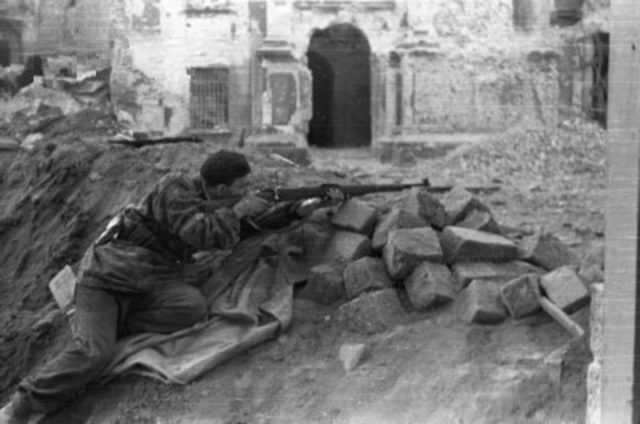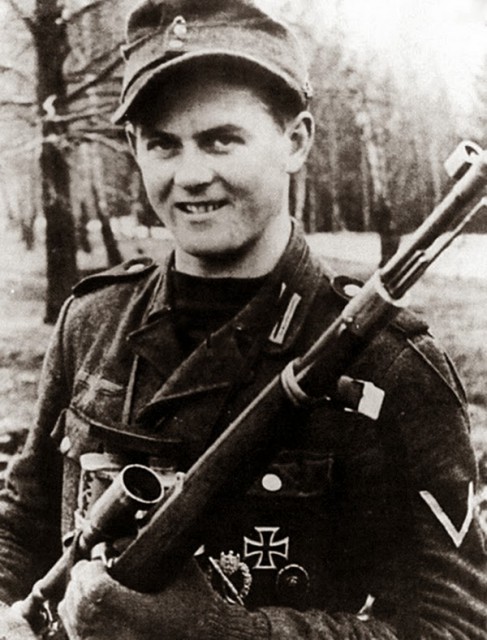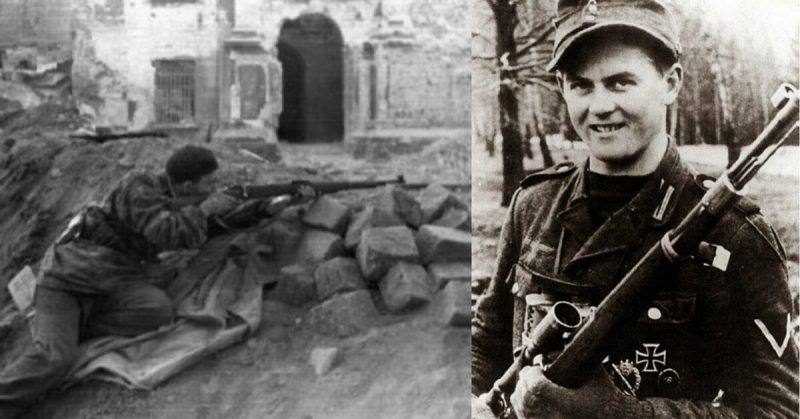Josef Allerberger and Matthäus Hetzenauer were two snipers in the German Army who left a trail of death and chaos in their wake.
The pair grew up in similar circumstances. Both were born in Austria. Both were born in December. Both were born in the same year and, eventually, both served on the Eastern Front.
Between them, they were credited with over 600 kills and terrorized Soviet soldiers over a two-year period.
Allerberger came from in the Austrian town of Wals-Siezenheim, which is located near the city of Salzburg to the east and the border with Germany to the west.
Although their final destination in the Wehrmacht was the same, the route they took into the sniper ranks was worlds apart. Allerberger was initially sent to the cold, brutal Eastern Front as a machine gunner.
His change of career came after he was wounded at Stavropol, a city in the North Caucasus. It had been captured by the Germans in 1943 and was used as a base for the Luftwaffe to bomb Soviet strategic positions in Grozny.
Stavropol might have only been held temporarily by the Nazi’s, but it made a permanent change in Allerberger.
While recovering from his wounds, the machine gunner experimented with a captured Soviet Mosin-Nagant rifle, equipped with a 3.5x PU sight. The weapon grew on the Austrian, and he made 27 kills with it before being sent for formal sniper training at Seetaleralpe.

While undergoing his training, the crack shot was handed a Karabiner 98k weapon with a 4x telescopic sight. Those weapons were chosen for sharpshooters because of their excellent accuracy during factory tests. There were, however, several design problems which meant customizing them with telescopic sights had to be done by an armorer.
Despite the success the Karabiner had throughout the war, Allerberger often used a Gewehr 43 with a 4x sight and an MP40 submachine gun.
To hide from his enemies and find the best place to shoot at Soviets he used the Wehrmacht technique of an umbrella with the cloth removed and foliage interweaved into the frame. Allerberger held it in front of his body as camouflage, which could be quickly changed and was adaptable to all kinds of different circumstances.
He lived by a mantra which got him safely through the war. He never fired at a target that had not been identified correctly; he only fired once from each position, and he thought that any hint of compassion with the enemy would lead to his death.
Those three rules resulted in him winning the Iron Cross (1st and 2nd class); an Infantry Assault Badge, the Sniper’s Badge (Gold) and the Knight’s Cross of the Iron Cross. For his actions in Stavropol, he was also awarded the Wound Badge (Silver).
At the same time, Hetzenauer was also operating on the Eastern Front and sending death into the ranks of the Soviets with unerring accuracy.
He came from Brixen im Thale, a town that lies among the mountains of the Kitzbühel Alps. He spent almost the whole of 1943 in basic training and was then transferred to sniper school from March to July 1944.

The mountain native spent his time, fighting in the 3rd Gebirgsjäger Division, a unit that was formed from the Austrian Army’s 5th and 7th Divisions after Hitler initiated the Anschluss in 1938.
The Division was involved in operations in Lapland in 1941 before fighting in Norway and acting as a reserve for Army Group North as they tried to take Leningrad. At the end of the war, they surrendered to the Soviets in Silesia.
Just like Allerberger, he used a Gewehr 43 with a 4x sight as well as a Karabiner 98k, but unlike his countryman, Hetzenauer saw action in Hungary, Slovakia, and the Carpathians.
Hetzenauer also picked up a Knight’s Cross of the Iron Cross as well as the Wound Badge (Black) after he suffered a head injury following artillery fire in November 1944.
An incredible 345 enemy soldiers fell to the deadly crack shot’s weapon. His longest confirmed kill was from an amazing 1,100 meters away. A distance only the most skilled in the trade would be able to pull off.
Hetzenauer was awarded his highest honor in April 1945. Paul Klatt, Generalleutnant, and Divisions commander recommended him due to the sheer volume of his kills as well as his disregard for his own safety while under artillery fire and enemy attacks.
The joy at being awarded such a prestigious medal did not last long as he was captured only one month later and spent five years in a Soviet prisoner of war camp. He died in October 2004, six years before Allerberger, who returned to his hometown and took up work as a carpenter, just like his father.
